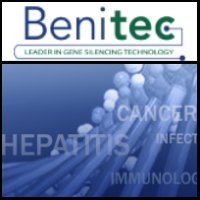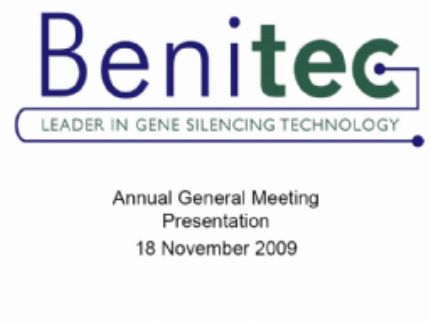
Benitec Limited (ASX:BLT) HIV/AIDS Stem Cell Clinical Trial Results Published In Science-Translational Medicine
Melbourne, June 17, 2010 AEST (ABN Newswire) - Benitec Limited ( ASX:BLT) (
ASX:BLT) ( PINK:BNIKF) are pleased to announce that the results of Benitec's US-based HIV/AIDS pilot clinical trial have been published in the prestigious scientific journal Science Translational Medicine, a journal published by the American Association for the Advancement of Science.
PINK:BNIKF) are pleased to announce that the results of Benitec's US-based HIV/AIDS pilot clinical trial have been published in the prestigious scientific journal Science Translational Medicine, a journal published by the American Association for the Advancement of Science.
The authors of the study report that the triple RNA therapy approach used to suppress HIV in AIDS-related lymphoma patients was safe and feasible. They concluded that the results support the development of an RNA-based cell therapy platform for HIV.
"The results are of particular significance for Benitec, who funded the trial along with the National Institutes for Health, as this study was the first human clinical trial of Benitec's technology of DNA-directed RNA interference (ddRNAi)" said Dr Peter French, Chief Executive Officer, Benitec Ltd.
Dr John Zaia of the City of Hope, the Principal Investigator on the trial, said, "These results demonstrate that Benitec's technology, coupled with two other proprietary anti-HIV RNA constructs, has the potential to provide a novel therapy for HIV. We are very pleased that the Company has undertaken to support further clinical studies with this very promising therapeutic vector."
A key step in bringing this vector to the clinic was to demonstrate that it is both safe and feasible to transfect the vector into human stem cells and for the RNA molecules to persist in the immune cells of the patient. The authors report that the procedure was safe in all four patients who underwent the transfection and, in at least three of the patients, the vector was detectable for at least 18 months post transfection.
Benitec recently announced that it has agreed to fund a second clinical trial at the City of Hope using the same triple vector to transfect T cells in HIV/AIDS patients who have failed HAART therapy. This trial, should it be successful, will provide evidence for a wider use of the vector in HIV therapy. The US FDA and the City of Hope Institutional Review Board have allowed the trial to proceed, and recruitment has commenced.
Background on Publication & Study
The paper is entitled " RNA-based Gene Therapy for HIV Using Lentiviral Vector-Modified CD34+ Cells in Patients Undergoing Autologous Stem Cell Transplantation for AIDS-Related Lymphoma". The authors included the study's Principal Investigators Professors David DiGiusto, Amrita Krishnan, and John Rossi and others from the City of Hope in Duarte, California.
The study recruited five patients with AIDS-related lymphoma, four of whose blood stem cells were harvested, transfected with the triple vector RNA therapeutic and then reinfused back into the patients. The study showed that the genetic treatment was successful, and three of the patients were still expressing the therapeutic molecules in their blood cells at 18 months (one out to 24 months).
It was a landmark trial for other reasons. It was the first clinical trial in HIV-infected humans using lentiviral vector transduction of human stem cells; it was the first trial to use a ddRNAi trigger (shRNA) in human blood cells derived from ex vivo gene-modified blood stem cells and it was the first trial to use a triple gene therapy combination. In cell culture studies this triple vector showed almost complete inhibition of HIV growth.
The key technical findings included:
- The process of isolation of CD34+ (blood stem) cells, their genetic modification using a lentivirus vector expressing multiple anti-HIV RNAs and autologous infusion is safe and feasible (Primary Aim)
- Of the measurable transgenes, expression of the siRNA and ribozyme has persisted for at least 18 months post-infusion - representing an initial milestone in the development of genetic therapy for HIV infection using stem cells;
- The trial resulted in the development of several key methods for trials such as this at the City of Hope - manufacturing procedures, release criteria, in vitro correlative assays of cell function and analytical tools for assessment of persistence in vivo.
- There was a low level frequency of transduced peripheral blood cells - consistent with the low number of infused gene-modified stem cells (Secondary Aim);
The triple vector used in this trial (rHIV7-shI-TAR-CCR5RZ) encoded three forms of anti-HIV RNA:
1) RNAi (shI) in the form of a short hairpin RNA (shRNA) targeted to HIV-1 tat/rev, a protein involved in the replication of the virus in human T cells,
2) a decoy containing the HIV trans-acting response element (TAR), which binds and sequesters Tat. The decoy also inhibits HIV replication via a different mechanism to the shRNA construct, and
3) a ribozyme (CCR5RZ) that targets the host cell CCR5 protein, which is a key molecule that HIV uses to bind to and enter human T cells.
About City of Hope
City of Hope is a leading research and treatment center for cancer, diabetes and other life-threatening diseases. Designated as a Comprehensive Cancer Center, the highest honor bestowed by the National Cancer Institute, and a founding member of the National Comprehensive Cancer Network, City of Hope's research and treatment protocols advance care throughout the nation. City of Hope is located in Duarte, Calif., just northeast of Los Angeles, and is ranked as one of "America's Best Hospitals" in cancer and urology by U.S.News & World Report. Founded in 1913, City of Hope is a pioneer in the fields of bone marrow transplantation and genetics. For more information, visit http://cityofhope.org.
Contact
Dr Peter French
Chief Executive Officer
Mob: +61-412-457-595
Email: pfrench@benitec.com
| ||
|




